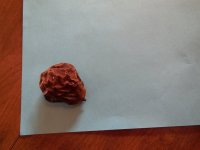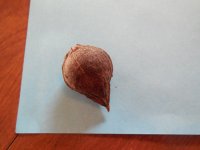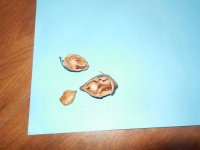Smart Red
Garden Master
- Joined
- Jan 10, 2012
- Messages
- 11,303
- Reaction score
- 7,395
- Points
- 417
- Location
- South-est, central-est Wisconsin
The large green tree and the small green thing near my bluebird house are my Heart nut trees.

I got my first ever nut from the tall tree this year. This is the nut complete with hull from the tree.
 This is the nut de-hulled.
This is the nut de-hulled.
This is the nut cracked open. It is a tough nut to crack.
 I sent it flying all around in my kitchen before I got it partly opened and saw the nut meat. Yum! A bit walnut-like, but different in a tasty way. Not going to be easy to get the nutmeats in few pieces.
I sent it flying all around in my kitchen before I got it partly opened and saw the nut meat. Yum! A bit walnut-like, but different in a tasty way. Not going to be easy to get the nutmeats in few pieces.
I got my first ever nut from the tall tree this year. This is the nut complete with hull from the tree.
 This is the nut de-hulled.
This is the nut de-hulled.
This is the nut cracked open. It is a tough nut to crack.
 I sent it flying all around in my kitchen before I got it partly opened and saw the nut meat. Yum! A bit walnut-like, but different in a tasty way. Not going to be easy to get the nutmeats in few pieces.
I sent it flying all around in my kitchen before I got it partly opened and saw the nut meat. Yum! A bit walnut-like, but different in a tasty way. Not going to be easy to get the nutmeats in few pieces.